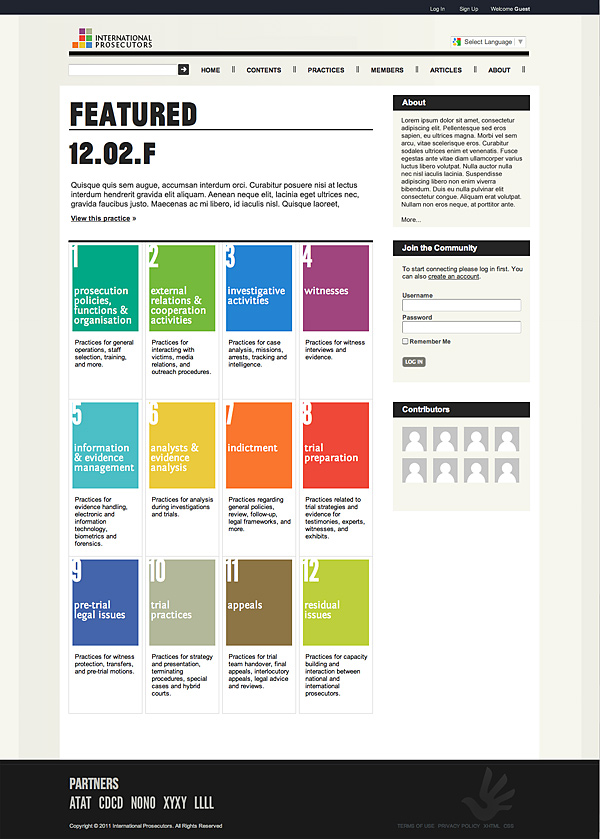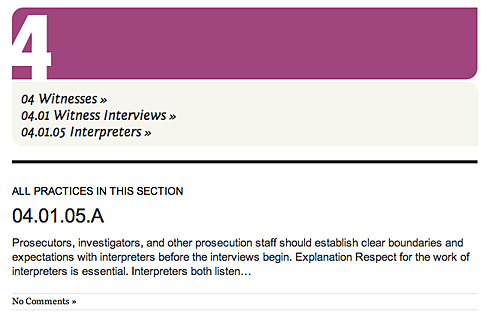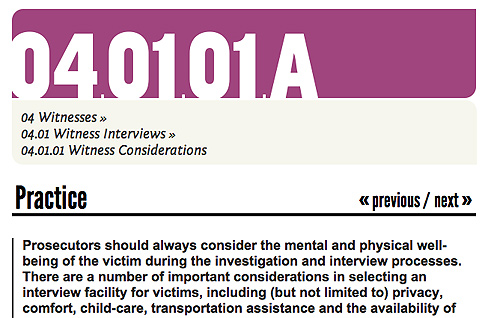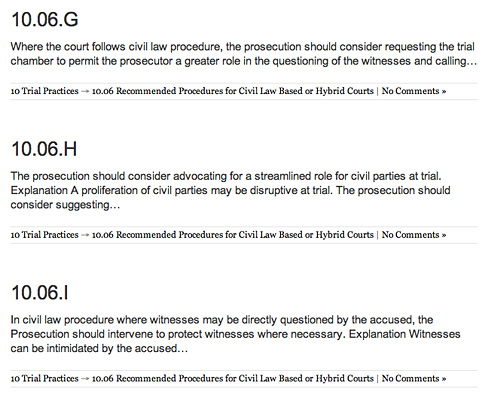

Project
International Prosecutors
Created: June 2011
No public URL available at this time
Goal
In the incredibly complex judicial system, prosecution of international crimes occurs at international tribunals, specially-designated courts established by the United Nations. The highest of these is the International Criminal Court seated at The Hague in the Netherlands, though ad hoc tribunals operate on a national level with limited jurisdiction. In these multilingual and multicultural environments, locally- and internationally-appointed prosecutors work in tandem with experts from across the world such as case managers, military and political analysts, and medical professionals. As each case is unique and geographically diverse, building a knowledge repository from these experiences, sharing lessons learned and identifying best practices can bring efficiencies to the practice of international humanitarian law -- something a small team of experienced international prosecutors and court veterans aims to achieve.
Services
- Information/Taxonomy Design
- Interaction/Web Design
- Prototyping
- Software Architecture
- Custom Buddypress Development (PHP, MySQL, XHTML, CSS)
The Challenge
With the project's final report at 269 pages, the challenge of the pilot website was to present the findings in a way that would engage and foster discussion among a niche group of practitioners comprised of investigators, prosecutors, analysts, legal support staff, educators, international law students, and the general public. Though they share a common interest, the target community is diverse and multinational.
The project team presented many functionality requirements, including:
- Retain the table of contents hierarchy
- Featured topics and practices
- Browse by subject, category and role
- Multi-author publishing
- Anonymous commenting
- Member-only content
- Community profiles
- Rating system
- Language translation
A key challenge of the project was to conceive a design that was bold enough to support its partners and the subject matter while inviting broad international appeal, all without the use of any photography or graphics. The variety of sensitive topics in the report made visual elements feel abstract and intangible.
Translating a written report to the web -- a visual, interactive medium -- is always a difficult task. Having it involve copious legal text was formidable. As the material needed to be presented in a table of contents structure without being altered or summarized, determining the ideal content architecture of the site was an exhaustive trail-and-error learning process.
The Solution
Written as operating protocols, information in the report is divided among 12 main sections and each section is further divided into subsections, with each of those listing a varying number of guidelines or practices. These 12 main report sections serve as the primary navigation.

Technically, each of the main section and subsection headings are Wordpress categories, and each individual practice is a Wordpress post. Because a primary goal of the site was to engage user comments and ratings, each practice needed to be a separate entity of its own: a post. While super easy for the site's content managers to maintain, displaying the table of contents on the front-end required some crafty PHP code and devising a numbering system for the practices, even though they were not numbered in the original document.
Numbering yielded several additional usability benefits:
- Shorter URLs
- Easier post management
- Easier referencing for discussion
As such, users are also able to paginate through the entire set of practices independent of the table of contents hierarchy. Along with searching, this provides an additional method for users to browse the material.


Breaking from the traditional conservative blue and grey combinations found on many government websites, vibrant color coding is used throughout the website as a wayfinding technique.
A full Buddypress installation powers the member profiles. Over time, project partners hope to use the blogging, forum and groups features. For the initial launch the site used Google Translate, though the platform supports human language translation options if integrated in the future.
Results
The pilot niche community website was demoed and well received at the International Prosecutors Colloquium meeting on 14-15 May 2011 in Freetown, Sierra Leone. Multi-governmental in scope, the project is currently in hiatus.
About the Client
The Special Court for Sierra Leone was established in 2002 to try those responsible for war crimes and crimes against humanity during the Sierra Leone Civil War. When the Special Court completes its proceedings in 2012, the court will become the first of the international tribunals created since the end of the Cold War to close its doors. With the departure of the last UN Peacekeepers, Sierra Leone's post-conflict transition is nearly complete. Through its legacy projects, the SCSL is laying the foundations for sustainable peace in Sierra Leone.
